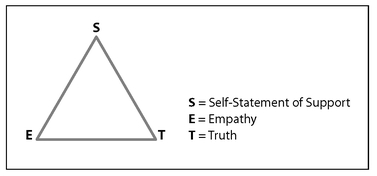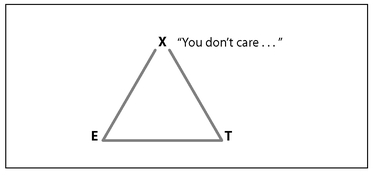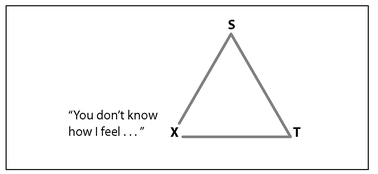I Hate You—Don't Leave Me (15 page)
Read I Hate You—Don't Leave Me Online
Authors: Jerold J. Kreisman

With the
Empathy
segment, one attempts to acknowledge the borderline's chaotic feelings with a “You” statement: “How awful you must be feeling.” It is important not to confuse empathy with sympathy (“I feel so sorry for you . . .”), which may elicit rage over perceived condescension. Also,
Empathy
should be expressed in a neutral way with minimal personal reference to the speaker's own feelings. The emphasis here is on the borderline's painful experience, not the speaker's. A statement like “I know just how bad you are feeling” invites a mocking rejoinder that, indeed, you do not know, and only aggravates conflict.
Empathy
segment, one attempts to acknowledge the borderline's chaotic feelings with a “You” statement: “How awful you must be feeling.” It is important not to confuse empathy with sympathy (“I feel so sorry for you . . .”), which may elicit rage over perceived condescension. Also,
Empathy
should be expressed in a neutral way with minimal personal reference to the speaker's own feelings. The emphasis here is on the borderline's painful experience, not the speaker's. A statement like “I know just how bad you are feeling” invites a mocking rejoinder that, indeed, you do not know, and only aggravates conflict.

FIGURE 5-1
The
T
statement, representing
Truth
or reality, emphasizes that the borderline is ultimately accountable for his life and that others' attempts to help cannot preempt this primary responsibility. While
Support
and
Empathy
are subjective statements confirming how the principals feel,
Truth
statements acknowledge that a problem exists and address the practical, objective issue of what can be done to solve it. “Well, what are you going to do about it?” is one essential
Truth
response. Other characteristic
Truth
expressions refer to actions that the speaker feels compelled to take in response to the borderline's behaviors, which should be expressed in a matter-of-fact, neutral fashion (“Here's what happened . . . These are the consequences . . . This is what I can do . . . What are you going to do?”). But they should be stated in a way that avoids blaming and sadistic punishing (“This is a fine mess you've gotten us into!” “You made your bed; now lie in it!”). The
Truth
part of the SET system is the most important and the most difficult for the borderline to accept since so much of his world excludes or rejects realistic consequences.
T
statement, representing
Truth
or reality, emphasizes that the borderline is ultimately accountable for his life and that others' attempts to help cannot preempt this primary responsibility. While
Support
and
Empathy
are subjective statements confirming how the principals feel,
Truth
statements acknowledge that a problem exists and address the practical, objective issue of what can be done to solve it. “Well, what are you going to do about it?” is one essential
Truth
response. Other characteristic
Truth
expressions refer to actions that the speaker feels compelled to take in response to the borderline's behaviors, which should be expressed in a matter-of-fact, neutral fashion (“Here's what happened . . . These are the consequences . . . This is what I can do . . . What are you going to do?”). But they should be stated in a way that avoids blaming and sadistic punishing (“This is a fine mess you've gotten us into!” “You made your bed; now lie in it!”). The
Truth
part of the SET system is the most important and the most difficult for the borderline to accept since so much of his world excludes or rejects realistic consequences.
Communication with the borderline should attempt to include all three messages. However, even if all three parts are stated, the borderline may not integrate all of them. Predictable responses result when one of these levels is either not clearly stated or is not “heard.”
For example, when the
Support
stage of this system is bypassed (see Figure 5-2), the borderline characteristically accuses the other of not caring or not wanting to be involved with him. The borderline then tends to tune out further exchanges on the basis that the other person does not care, or may even wish him harm. The borderline's accusation that “You don't care!” usually suggests that the
Support
statement is not being integrated.
Support
stage of this system is bypassed (see Figure 5-2), the borderline characteristically accuses the other of not caring or not wanting to be involved with him. The borderline then tends to tune out further exchanges on the basis that the other person does not care, or may even wish him harm. The borderline's accusation that “You don't care!” usually suggests that the
Support
statement is not being integrated.

FIGURE 5-2
The inability to communicate the
Empathy
part of the message (see Figure 5-3) leads to feelings that the other person does not understand what the borderline is going through. (“You don't know how I feel!”) Here, the borderline will justify his rejection of the communication by saying he is misunderstood. Since the other person cannot appreciate the pain, his responses can be devalued. When either the
Support
or the
Empathy
overtures are not accepted by the borderline, further communications are not heard.
Empathy
part of the message (see Figure 5-3) leads to feelings that the other person does not understand what the borderline is going through. (“You don't know how I feel!”) Here, the borderline will justify his rejection of the communication by saying he is misunderstood. Since the other person cannot appreciate the pain, his responses can be devalued. When either the
Support
or the
Empathy
overtures are not accepted by the borderline, further communications are not heard.

FIGURE 5-3
When the
Truth
element is not clearly expressed (see Figure 5-4), a more dangerous situation emerges. The borderline interprets others' acquiescence in ways he finds most comfortable for his needs, usually as confirmation that others really can be responsible for him, or that his own perceptions are universally shared and supported. The borderline's fragile merger with these other people eventually disintegrates when the relationship is unable to sustain the weight of his unrealistic expectations. Without clearly stated
Truth
and confrontation, the borderline continues to be overly entangled with others. His needs gratified, the borderline will insist that all is well or, at least, that things will get better. Indeed, the evidence for this enmeshment is often a striking, temporary absence of conflict: The borderline will exhibit less hostility and anger. However, when his unrealistic expectations are eventually frustrated, the relationship collapses in a fiery maelstrom of anger and disappointment.
Truth
element is not clearly expressed (see Figure 5-4), a more dangerous situation emerges. The borderline interprets others' acquiescence in ways he finds most comfortable for his needs, usually as confirmation that others really can be responsible for him, or that his own perceptions are universally shared and supported. The borderline's fragile merger with these other people eventually disintegrates when the relationship is unable to sustain the weight of his unrealistic expectations. Without clearly stated
Truth
and confrontation, the borderline continues to be overly entangled with others. His needs gratified, the borderline will insist that all is well or, at least, that things will get better. Indeed, the evidence for this enmeshment is often a striking, temporary absence of conflict: The borderline will exhibit less hostility and anger. However, when his unrealistic expectations are eventually frustrated, the relationship collapses in a fiery maelstrom of anger and disappointment.

FIGURE 5-4
Borderline DilemmasThe SET-UP principles can be used in a variety of settings in attempts to defuse unstable situations. Following are some typical borderline predicaments in which the SET strategy may be used.
Damned If You Do, and Damned If You Don'tBorderline confusion often results in contradictory messages to others. Frequently, the borderline will communicate one position with words, but express a contradictory message with behavior. Although the borderline may not be consciously aware of this dilemma, he frequently places a friend or relation in a no-win situation in which the other person is condemned no matter which way he goes.
CASE 1: GLORIA AND ALEX.
Gloria tells her husband Alex that she is forlorn and depressed. She says she plans to kill herself but forbids him from seeking help for her.
Gloria tells her husband Alex that she is forlorn and depressed. She says she plans to kill herself but forbids him from seeking help for her.
In this situation, Alex is confronted with two contradictory messages: (1) Gloria's overt message, which essentially states, “If you care about me, you will respect my wishes and not challenge my autonomy to control my own destiny and even die, if I choose”; and (2) the opposite message, conveyed in the very act of announcing her intentions, which says, “For God's sake, if you care about me, help me, and don't let me die.”
If Alex ignores Gloria's statements, she will accuse him of being cold and uncaring. If he attempts to list reasons why she should not kill herself, she will frustrate him with relentless counter-arguments and will ultimately condemn him for not truly understanding her pain. If he calls the police or her doctor, he will be rejecting her requests and proving that she cannot trust him.
Because Gloria doesn't feel strong enough to take responsibility for her own life, she looks to Alex to take on this burden. She feels overwhelmed and helpless in the wake of her depression. By drawing Alex into this drama, she is making him a character in her own scripted play, with an uncertain ending to be resolved not by herself, but by Alex. She faces her ambivalence about suicide by turning over to him the responsibility for her fate.
Further, Gloria splits off the negative portions of her available choices and projects them onto Alex, preserving for herself the positive side of the ambivalence. No matter how Alex responds, he will be criticized. If he does not actively intercede, he is uncaring and heartless and she is “tragically misunderstood.” If he tries to stop her suicide attempts, he is controlling and insensitive, while she is bereft of her self-respect.
Either way, Gloria envisions herself a helpless and self-righteous martyrâa victim who has been deprived by Alex of achieving her full potential. As for Alex, he is damned if he does and damned if he doesn't!
SET-UP principles may be helpful in confronting a difficult situation like this. Ideally, Alex's responses should embrace all three sides of the SET triangle. Alex's
S
statement should be a declaration of his commitment to Gloria and his wish to help her: “I am very concerned about how bad you are feeling and want to help because I love you.” If the couple can identify the specific areas of concern that are adding to her anguish, he could suggest solutions and proclaim his willingness to help: “I think some of this might be related to the problems you've been having with your boss. Let's discuss some of the alternatives. Maybe you could ask for a transfer. Or if the job is causing you this much difficulty, I want you to know that's okay with me if you want to quit and look for another job.”
S
statement should be a declaration of his commitment to Gloria and his wish to help her: “I am very concerned about how bad you are feeling and want to help because I love you.” If the couple can identify the specific areas of concern that are adding to her anguish, he could suggest solutions and proclaim his willingness to help: “I think some of this might be related to the problems you've been having with your boss. Let's discuss some of the alternatives. Maybe you could ask for a transfer. Or if the job is causing you this much difficulty, I want you to know that's okay with me if you want to quit and look for another job.”
The
E
statement should attempt to convey Alex's awareness of Gloria's current pain and his understanding of how such extreme circumstances might lead her to contemplate ending her life: “The pressure you've been under these past several months must be getting unbearable. All of this agony must be bringing you to the edge, to a point where you feel like you just can't go on anymore.”
E
statement should attempt to convey Alex's awareness of Gloria's current pain and his understanding of how such extreme circumstances might lead her to contemplate ending her life: “The pressure you've been under these past several months must be getting unbearable. All of this agony must be bringing you to the edge, to a point where you feel like you just can't go on anymore.”
The most important part of Alex's
T
statement should identify his untenable “damned-if-he-does and damned-if-he-doesn't” dilemma. He should also attempt to clarify Gloria's ambivalence about dying by acknowledging that in addition to that part of her that wants to end her life, another part of her wishes to be saved and helped. Alex's
T
responses might be something like: “I recognize how bad you are feeling and your wish to die. I know you said that if I cared at all for you, I should just leave you alone. But if I cared, how could I possibly sit back and watch you destroy yourself? Your alerting me to your suicidal plans tells me that, as much as you may wish to die, there is at least some part of you that doesn't want to die. And it is to that part that I feel I must respond. I want you to come with me to see a doctor to help us with these problems.”
T
statement should identify his untenable “damned-if-he-does and damned-if-he-doesn't” dilemma. He should also attempt to clarify Gloria's ambivalence about dying by acknowledging that in addition to that part of her that wants to end her life, another part of her wishes to be saved and helped. Alex's
T
responses might be something like: “I recognize how bad you are feeling and your wish to die. I know you said that if I cared at all for you, I should just leave you alone. But if I cared, how could I possibly sit back and watch you destroy yourself? Your alerting me to your suicidal plans tells me that, as much as you may wish to die, there is at least some part of you that doesn't want to die. And it is to that part that I feel I must respond. I want you to come with me to see a doctor to help us with these problems.”
Depending on the immediacy of the circumstances, Alex should insist that Gloria be psychiatrically evaluated soon or, if she is in imminent danger, he should take her to an emergency room or seek help from police or paramedics.
At this juncture Gloria's fury may be exacerbated as she blames Alex for forcing her into the hospital. But
Truth
statements should remind Gloria that she is there not so much because of what Alex did, but because of what Gloria didâthreatening suicide. The borderline may frequently need to be reminded that others' reactions to him are based primarily on what
he
does, and that
he
must take responsibility for the consequences, rather than blaming others for realistic responses to his behavior.
Truth
statements should remind Gloria that she is there not so much because of what Alex did, but because of what Gloria didâthreatening suicide. The borderline may frequently need to be reminded that others' reactions to him are based primarily on what
he
does, and that
he
must take responsibility for the consequences, rather than blaming others for realistic responses to his behavior.
When the immediate danger has passed, subsequent
T
statements should refer to Gloria's unproductive patterns of handling stress and the need to develop more effective ways of dealing with her life.
Truth
considerations should also include how Gloria's and Alex's behaviors affect each other and their marriage. Over time they may be able to work out a system of responding to each other, either on their own or within therapy, that will fulfill the needs of both.
T
statements should refer to Gloria's unproductive patterns of handling stress and the need to develop more effective ways of dealing with her life.
Truth
considerations should also include how Gloria's and Alex's behaviors affect each other and their marriage. Over time they may be able to work out a system of responding to each other, either on their own or within therapy, that will fulfill the needs of both.
Other books
Bridget Jones: Mad About the Boy by Helen Fielding
The Assault by Harry Mulisch
Jungle Surprises by Patrick Lewis
Unconventional (The Manhattanites #4) by Avery Aster
When I'm With You Part III by Beth Kery
Avenging Angel by Rex Burns
Send in the Clowns, a Detective Mike Bridger novel by Mark Bredenbeck
Valley of the Gun (9781101607480) by Cotton, Ralph W.
Agnes Grey by Anne Bronte